Hendrik Duurkoop’s gravestone
The gravestone of Hendrik Duurkoop in the Dutch Cemetery at Goshinji temple in Nagasaki has long been famous as the oldest surviving gravestone in Japan belonging to a European.[1] Duurkoop, who divided most of his adult life between Batavia (modern-day Jakarta) and Nagasaki, died at sea at the age of 42 en route to his second posting as director (opperhoofd) of the Dutch factory at Dejima. This essay assembles the available historical materials in Dutch and Japanese to give a brief account of Duurkoop’s life and the history of his gravestone after his death.[2]
Hendrik Godfried Duurkoop (German: Hendrick Gottfried Dürkopp) was born on May 5, 1736, in Dornum, Eastern Friesland (today part of Aurich in Lower Saxony, Germany).[3] He was baptized three days later in the nearby St. Bartholomäus Church. In 1754, he joined the Dutch East Indies Company (Verenigde Oost-Indische Compagnie or “VOC”) in Amsterdam, and on December 31 of the same year he set sail on the Overnes for Batavia in the Dutch East Indies. He was just 19 years old when he arrived in Asia.
It seems that Duurkoop worked in Batavia for some years after his arrival in 1755, because his name does not appear in the diary of the director of the Dutch factory at Dejima until February 1764. In that first entry, he is mentioned as an assistant on the voyage to the shogun’s court in Edo led by director Jan Crans. Duurkoop would join the annual voyage to Edo three more times over the course of his life, in 1766, 1770, and 1777. Records reveal that he enjoyed a successful career in Japan, rising through the company’s ranks to become bookkeeper in 1770 and warehouse-master in 1773.
Eventually, Duurkoop was appointed factory director, taking on responsibility for the VOC’s entire trade with Japan. After returning to Dejima from Batavia on July 31, 1776,[4] he formally accepted the appointment upon the previous director’s departure and held the position for just over a year, as was usual at the time. This first posting as director, however, would also prove his last.
On December 13, 1777, Duurkoop handed the reins to the next factory director, Arend Willem Feith, and set sail for Batavia. In the summer of 1778, he set out for Japan again on the Huis te Spijk to resume the directorship for a second term, but he died unexpectedly at sea on July 27. His body arrived at Nagasaki on August 9 “in a lead coffin.”
According to Feith’s entry in the director’s diary for that day, when the Japanese authorities learned of Duurkoop’s death, they pressed Feith to resolve the matter quickly. The Japanese made several specific requests of the Dutch. That Duurkoop had died at sea was to be concealed; instead, in accordance with Japanese custom, the Dutch were to pretend that Duurkoop had arrived in Nagasaki unwell but alive, then report that his illness had taken a turn for the worse, then finally announce his “death.”
The Dutch complied, arranging for an assistant to play the role of a severely ill but still living Duurkoop for the landing at Dejima. The details after this are not clear, but on August 15 a funeral was held for Duurkoop at Goshinji. Feith was still director then, having lost his intended successor, and his entry in the director’s diary for that date is as follows:
Saturday, August 15
[...] Hendrik Godfried Duurkoop’s remains were interred with all the ceremony conditions here allowed, to the astonishment of the Japanese.[5]
However, it appears that Duurkoop’s massive gravestone was not completed in time for the interment. The director’s diary records that it was taken to Inasa on January 4, 1779, along with the gravestone for another VOC employee named Jan Schuts (d. October 24, 1777; buried October 26). Company representatives visited the temple again on January 7 to confirm that the gravestones had been properly placed.[6] The inscription on Duurkoop’s gravestone is in Latin and Dutch. Transcribed from a rubbing of the gravestone,[7] it reads:
MORA
SINE VOLAT
HORA
TER GEDAGTENISSE
VAN HET HIER RUSTEND GEBEENTE
VAN WYLEN DEN WELEDELEN
ACHTBAAREN HEER
HENDRIK GODFRIED
DUURKOOP
IN LEEVEN
OPPERKOOPMAN EN OPPERHOOFD
VAN WEEGENS DEN HANDEL
DER NEEDERLANDSCHE
GEOCTROYEERDE OOST
INDIASCHE COMPAGNIE
IN DIT KEYSERRYK
GEBOOREN
TE DOORNUM IN OOST VRIESLAND
DEN V MAY AO MDCCXXXVI
OVERLEDEN
OP HET SCHIP ‘T HUYS TE SPYK
OP DE NOORDER BRETE VAN 26 GR 58 M
DEN XXVII JULY
IN DEN OUDERDOM
VAN XXXXII JAAREN
II MAANDEN EN XXII DAGEN
EN DEN SCHOOT DER RUST
AANBETROUWD
DEN XV AUGO MDCCLXXVIII
In English:[8]
WITHOUT
DELAY TIME
FLIES
IN MEMORY
OF THE BONES RESTING HERE
OF THE LATE RIGHT HONORABLE
GENTLEMAN
HENDRIK GODFRIED
DUURKOOP
IN HIS LIFETIME
CHIEF MERCHANT AND DIRECTOR
OF THE TRADE OF THE
CHARTERED DUTCH EAST
INDIA COMPANY
IN THIS REALM
BORN
IN DOORNUM IN EAST FRIESLAND
ON 5 MAY 1736
PASSED AWAY
ON THE SHIP ‘T HUYS TE SPYK
AT 26 DEGREES 58 MIN. NORTHERN LATITUDE
ON JULY 27
AT THE AGE
OF 42 YEARS
2 MONTHS AND 22 DAYS
LAID TO REST
ON 15 AUGUST 1777
The Latin motto at the beginning, sine more volat hora (“Without delay time flies”), was commonly seen on graves and sundials in Europe,[9] and the winged hourglass symbolized the fleeting hours of man’s life on Earth.[10] The relief of a lamb and cross at the bottom of the inscription is a surprising inclusion given that it must have been overlooked by the Nagasaki officials responsible for enforcing the prohibition on Christianity.[11]
Morishima Chūryō’s 1787 Kōmo zatsuwa (Red-hair Miscellany) includes a detailed account of Duurkoop’s funeral:
Red-hair funerals
Regarding the funeral rites held at Goshinji (this is a temple that buries red-hairs; it is of the Zen sect) at Mt Inasa, Nagasaki, for the body of the kapitan named Duurkoop who died at sea while traveling from Java to Japan some years ago, I heard from [Ōtsuki] Gentaku that the body’s abdomen was opened, its organs removed and replaced with stuffing, the incision sewn back up (this is to prevent the corpse decomposing. It is said that all the gentry in that land receive this treatment. This must be considered in conjunction with the matter of mummies below), the body dressed in black clothing and laid in a horizontal coffin (black clothing is the mourning dress of that country. Details are given below), and the coffin carefully stuffed with various items, sealed with pitch, and secured on board a ship through a number of days; after its arrival on shore at Nagasaki, the coffin was draped in black velvet for the funeral ceremony and prepared for carrying on the shoulders with two poles lengthwise and three crosswise.
Many foreigners came to Goshinji for this farewell, each wearing black mourning dress and headgear cut from black habutae silk which draped down on both sides of their heads onto their shoulders. The digging of a deep hole and interment of the coffin was not especially different from what is done in our country (I am told that this practice is usual at Chinese funerals too). The gravestone was laid flat. It had an inscription in European letters on it. Towards one end of its face was carved a design of an hourglass with birds’ wings. This is something like the rebuses of our land. The fall of the last grain of sand through the hourglass is likened to the cessation of breath, and the wings are said to symbolize that although this person may die, his fame will fly ten million miles. The people of that land often write their metaphors as pictures. Most are combinations of imagery of this sort.
The kapitan’s funeral witnessed by Hayashi Shihei was the same as Gentaku’s account. The Dutch had the twenty day laborers acting as pallbearers wear a sign with a symbol on it, and the coffin and the foreigners come to see it off traveled the 18 chō [approximately 2 km] from the watergate of Dejima to Inasa by sea. Both the ship carrying the coffin and the kapitan’s ship accompanying were flying a striped flag.
When they carried the coffin to the Buddhist altar at Goshinji, the priests resident there as well as others from all the temples of Nagasaki emerged to recite sutras. Everything after that was left to the customs of the temple. The amusing thing was the eulogy by the priest. How could it enter the ears of a dead red-hair? With no interpreter, he would surely be unable to understand it.[12]
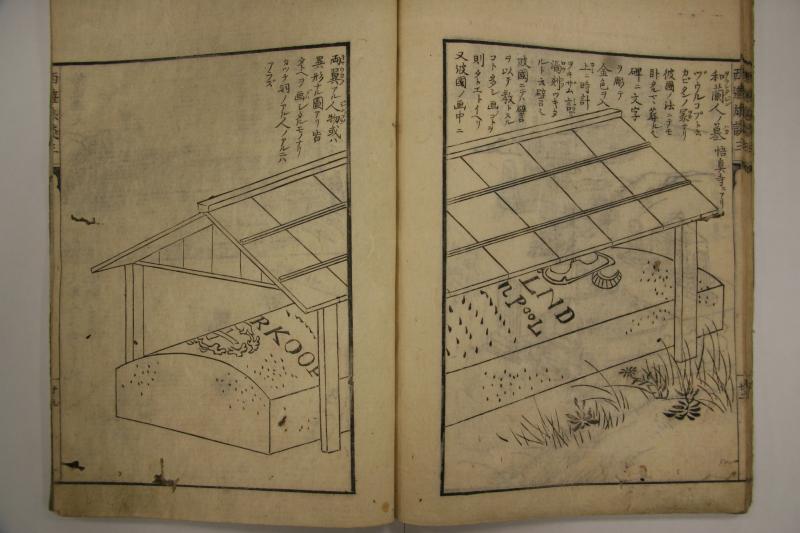 Illustration of the monument of Duurkoop in Shiba Kōkan’s Saiyū ryotan.
Illustration of the monument of Duurkoop in Shiba Kōkan’s Saiyū ryotan.
Allegedly based on reports from Ōtsuki Gentaku (1757–1827) and Hayashi Shihei (1738–1793), Morishima offers a richly detailed account covering the preparation of the body, the way the coffin was decorated and carried for the funeral, the color and form of Dutch mourning dress, the departure of the body from Dejima, and the recitation of sutras by the priests. However, while Shihei did visit Nagasaki in 1778, Gentaku’s stay in Nagasaki—the fulfillment of a long-held dream—lasted from 1785 to 1786, and so he cannot possibly have seen Duurkoop’s funeral for himself.[13]
Accounts of Duurkoop’s grave were offered by many curious-minded visitors to Nagasaki in following years, making it possible to trace the gravestone’s history to a certain extent. For example, in Shiba Kōkan’s Saiyū ryotan (Tales of a Journey to the West), based on his 1788 visit to Nagasaki, the grave is depicted with a striking full-sized canopy which no longer exists today. Furthermore, according to Kōkan, at the time the inscription on the gravestone was adorned with gold or gold leaf inlay. The caption to the illustration in Saiyū ryotan is as follows:
A Dutch grave. It is at Goshinji.
Grave of a kapitan named “Duurkoop.” Interred lying down according to the ways of his country. The gravestone has an inscription decorated in gold, and an hourglass carved at the top. This is meant as a metaphor for time running out. In their country, metaphors are often used as lessons. Pictures are even called “metaphors.” Other pictures from that country depict people with wings or other oddities. These are all metaphors made into pictures. It is not the case that people with wings once existed.[14]
Kōkan also mentions the grave in his Saiyū nikki (Diary of a Journey to the West):
26th day [of 10th month, 1788]: Some rain. Visited Goshinji across the bay in Inasa, and saw the Chinese and Dutch graves. All were buried lying down. The gravestone of the Dutchman Duur Koop [sic!] was shaped like a kamaboko fish-cake [with a semi-circular or D-shaped cross-section] and had some Dutch writing inscribed on it with gold leaf inlay and an hourglass carved at the top. This is a metaphor for time running out.[15]
The gold leaf inlay seems to have weathered away over the centuries, since not a trace of it remains today. However, in one black and white photograph from 1927, the lettering and relief work stands out sharply in white, hinting at the gravestone’s earlier appearance.[16]
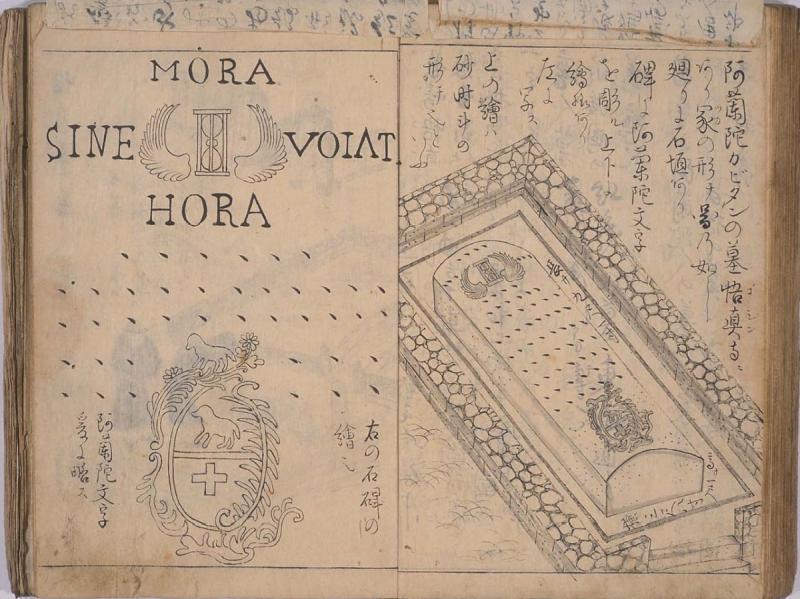 Illustration in Tazawa Harufusa’s Nagasaki yūkan zue.
Illustration in Tazawa Harufusa’s Nagasaki yūkan zue.
As for the canopy, Katsuragawa Hoshū (1751–1809) explicitly mentions a “rain-cover” (amaōi) in his 1794 Hokusa bunryaku (Brief Report on the Northern Drift),[17] but it seems to have been lost soon afterwards. Both Nagasaki yūkan zue (An Illustrated Guide to Sightseeing in Nagasaki) by Tazawa Harufusa, who visited the region in 1807–1808, and Nagasaki kibun (Tidings from Nagasaki), really a variant text of the above, include illustrations of the grave,[18] but the canopy observed by Kōkan is absent from both, replaced by a stone wall surrounding the grave. The illustrations in the two books are almost identical, but Nagasaki yūkan zue has a more detailed caption and also includes the dimensions of the gravestone.
The text in the body of the work reads:
At this temple [Goshinji] is a Dutch grave. The grave is kamaboko-shaped, something like the lid of a long chest. An illustration is included at the end of this work.
The caption to the illustration is as follows:
The Dutch kapitan’s grave. This is at Goshinji. Its shape is as shown in the picture. It is surrounded by a stone wall. Dutch writing is inscribed on the gravestone. There are pictures at the top and bottom. These are copied to the left. The top picture is said to depict an hourglass.[19]
The dimensions are given as “Length: 9 shaku 1 sun. Width: 3 shaku 8 sun. Height: 1 shaku,” approximately 2750 mm×1150 mm×300 mm. The stone wall visible in Tazawa’s illustration no longer exists, but because the ratio of the dimensions given matches the ratio of the gravestone’s current dimensions (2810 mm×1160 mm×230/300 mm) almost exactly, and the two reliefs are depicted with considerable accuracy, the illustration was probably based on direct observation.
Piecing together these fragmentary materials, a rather complicated picture of the history of Duurkoop’s gravestone emerges: it has a canopy initially, then loses it and gains a stone wall instead, before finally losing the stone wall as well to arrive at its current state.
Hirokawa Kai, a practitioner of Western-style medicine in Kyoto who spent a total of six years in Nagasaki in the late 18th century, includes an “Illustration of a Dutch Grave” in his 1800 Nagasaki bunkenroku (Record of Observations in Nagasaki), with the following comment:
A Dutch grave is at Goshinji in Inasa, Nagasaki. Long ago, when a kapitan died at sea, he was pickled in sugar and brought to this temple to be interred. His grave is here. Of course, those below the kapitan, such as black matrozen [sailors], had no graves. They were simply buried as they were, on par with fallen dogs or horses. Those who died at sea were reportedly thrown overboard. Furthermore, no incense is offered at the kapitan’s grave. It is said that only the prostitutes to whom he showed kindness come to pay their respects. In any case, no text is inscribed on the gravestone. A monument of three stones stands before it. This bore an account of the grave written by the priests of the temple. It was therefore written in Chinese characters. However, this too has been worn away and is no longer visible. The form of the grave is shown to the left.[20]
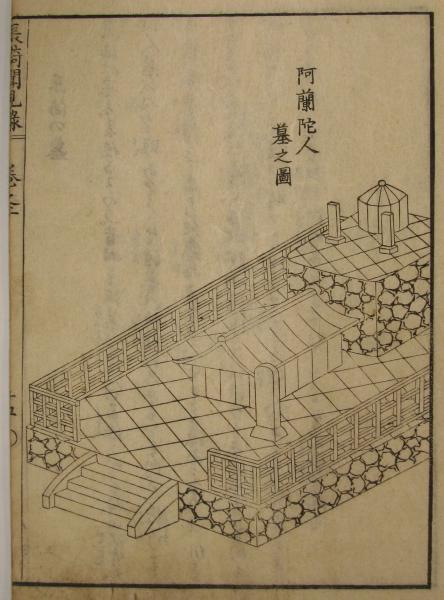 “Illustration of a Dutch grave” in Hirokawa Kai’s Nagasaki bunkenroku
“Illustration of a Dutch grave” in Hirokawa Kai’s Nagasaki bunkenroku
Although Hirokawa does not name the kapitan, he seems to be speaking of Duurkoop. Some have inferred from this that Duurkoop’s grave was originally within the Dutch Cemetery in a location slightly higher than its current one, as Hirokawa’s illustration seems to show.[21] However, Hirokawa’s illustration also depicts a large platform behind the grave with a shrine-like stone structure atop it, neither of which can be found in the Edo-period sources mentioned above, or indeed in the Dutch Cemetery today. Other details in Hirokawa’s account—particularly the claim that the gravestone has no inscription—make it difficult to believe that he actually saw Duurkoop’s grave at all.
On the other hand, there is a site within the Chinese Cemetery at Goshinji that matches Hirokawa’s account almost exactly: the ossuary (kotsudō 骨堂) group constructed in 1760.
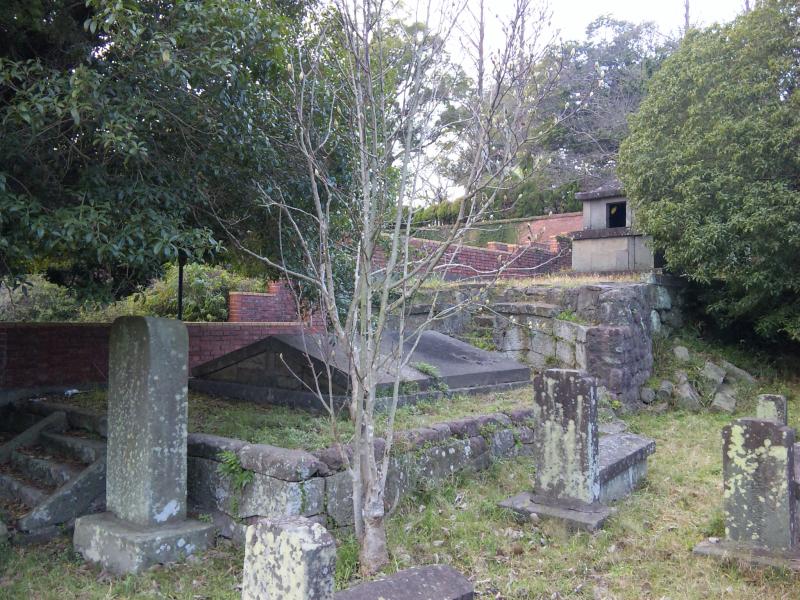 Ossuary group inside the Chinese Cemetery at Goshinji.
Ossuary group inside the Chinese Cemetery at Goshinji.
According to Nagasaki meishō zue (Illustrated Famous Sites of Nagasaki), the ossuary group includes “a stone shrine on a platform; it was erected during the Hōreki era [1751–1764] using a set of Guangdong stone brought by Chinese ships to replace an earlier site that had been damaged”.[22] An early 19th-century depiction of the ossuary group site can be found in Tazawa’s Nagasaki yūkan zue with the caption “Illustration of the Chinese graveyard at Goshinji”.[23]
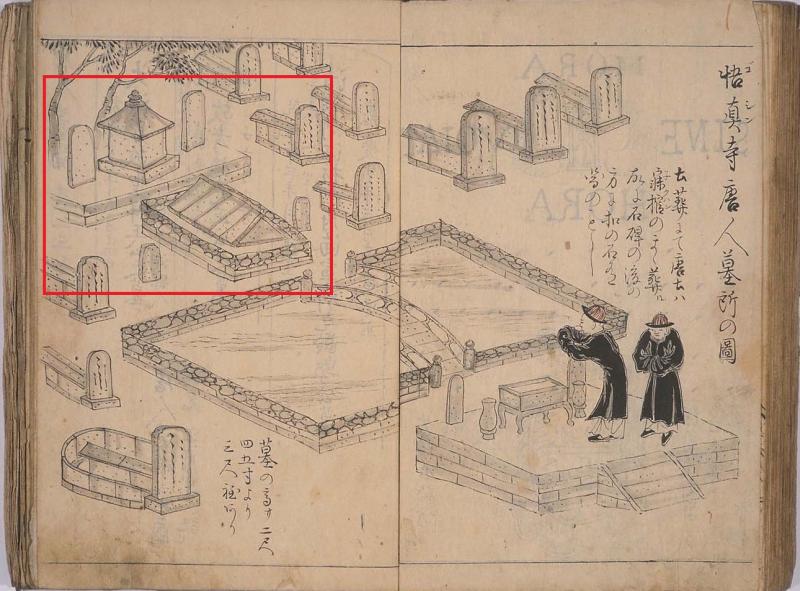 “Illustration of the Chinese graveyard at Goshinji” in Tazawa Harufusa’s Nagasaki yūkan zue (red frame added by author).
“Illustration of the Chinese graveyard at Goshinji” in Tazawa Harufusa’s Nagasaki yūkan zue (red frame added by author).
This illustration contains many details that clearly match Hirokawa’s, such as the raised stone shrine with steles to the left and right. Given that the inconsistencies in Hirokawa’s description can also be explained by the hypothesis that he was writing about the ossuary group, it seems safe to assume that this is indeed the case—that his “Illustration of a Dutch grave” actually depicts the ossuary group instead.
Duurkoop’s gravestone also appears in a photograph taken in 1865 by Anthonius Franciscus Bauduin (1820–1885) (figure 34). [24] Bauduin was second vice-principal of the Nagasaki Yōjōsho, the first modern Western-style hospital and medical school in Japan. The gravestone can be seen at the bottom of the frame, slightly right of center. Close examination of the relative positions of other graves in the photo confirms that, at least by the time of this photo, the gravestone was already in its current location. Bauduin took other photographs of Goshinji and its priests as well,[25] a fact which speaks to the deep impression made on him by this peculiar and distinctively “Nagasakian” space—a Buddhist temple in which his Dutch forebears rested in peace.
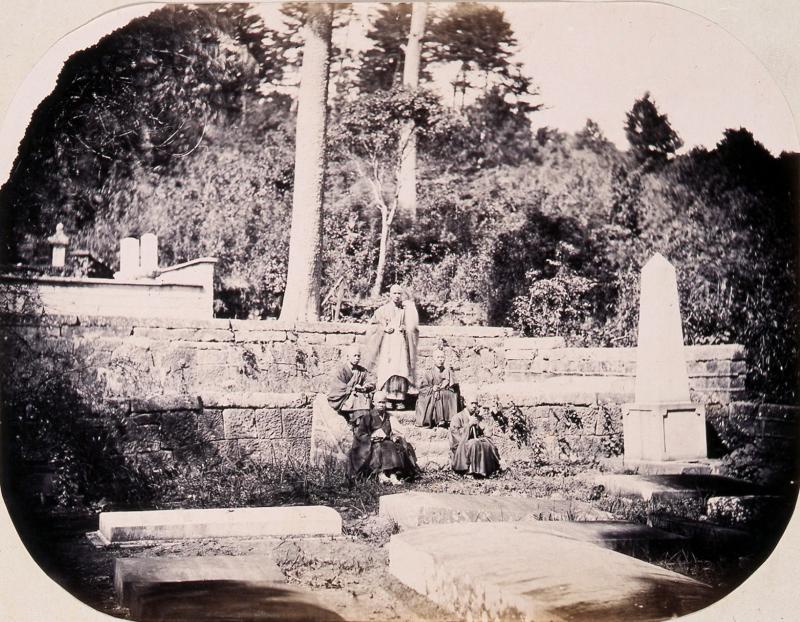 Cemetery and priests at Goshinji.
Cemetery and priests at Goshinji.
Considered together, these sources show that Duurkoop’s gravestone aroused interest in early modern Japan from a variety of perspectives, most notably Western funeral culture and iconography, and strongly impressed Dutch visitors to Nagasaki in later times. Even today, Duurkoop’s grave plays a key role in Japanese-Dutch relations: every newly appointed Dutch ambassador pays a visit to Nagasaki to offer flowers at the Dutch Cemetery at Goshinji, symbolically acknowledging the long shared history of the two nations.[26] Having weathered two centuries to date, Duurkoop’s gravestone is sure to remain a vital part of Nagasaki’s cultural heritage for many more.
Acknowledgments
I wish to express my gratitude to Isabel Tanaka-van Daalen for her numerous and invaluable comments on an earlier version of this paper.
* This is a reproduction of an article that appeared under the title “The gravestone of Hendrik Duurkoop, director of the Dutch trading post at Dejima, Nagasaki” in The Journal of the graduate school of language & literature, Prefectural University of Kumamoto, vol. 10, 2017. We are grateful for the kind permission from the editorial board of the journal to reproduce it here. The original article itself is an English translation of “Dejima shōkanchō Dyurukōpu bohi ni tsuite,” by the same author published in Japanese in Ōishi 2012, pp. 585–591. Note that, after the appearance of the original Japanese version, the following works have been published: Titia Van der Eb-Brongersma, “The Burial of Hendrik Godfried Duurkoop at Goshinji”, Nederlands Genootschap voor Japanse Studiën, uploaded August 20, 2015, available at: http://www.ngjs.nl/files/artikelen/New%20version%20Duurkoop.pdf (Accessed June 27, 2017); Titia Van der Eb-Brongersma, De Hollandsche begraafplaats in Nagasaki –Een cultuurhistorisch erfgoed, Oegstgeest: Hans Meijeraan, 2016; Tanaka Yūsuke 田中裕介. Nihon Kinsei ni okeru gairaikei bohi no henyō katei ni kansuru jisshōteki kenkyū: 2014-2016 nendo kagaku kenkyūhi josei jigyō (kiban kenkyū C) kenkyū seika hōkokusho (kadai bangō 24820071) 日本近世における外来系墓碑の変容過程に関する実証的研究; 2014-2016 年度科学研究費助成事業 (基盤研究C) 研究成果報告書 (課題番号24820071). Beppu: Tanaka Yūsuke, 2017.
[1] However, the gravestone of Francisco Gracias (d. 1589, Nagasaki) would be older if it still existed (Kataoka 1979, pp. 522–523). This gravestone was said to be at Daionji temple in Nagasaki towards the end of the Edo period, but it was reportedly taken back to Portugal by another Portuguese visitor after the opening of Japan’s ports in the 1850s and its whereabouts are currently unknown. However, a picture of the gravestone is stored at the Nagasaki Museum of History and Culture (call number: Kirisuto-kyō 18). See “Nagasaki 45: ‘BASTiAN’ Kirishitan bohi” in Ōishi 2012, pp. 196–198.
[2] Earlier research on Duurkoop’s gravestone and the Dutch Cemetery at Goshinji includes Masuda 1927, vol. 1, nos. 199–200; Itazawa 1955; Itazawa 1959, pp. 526–534; Kizu 1973; Kizu 1986; Miyanaga 1989; Earns and Burke-Gaffney 1991, pp. 16–17; Miyanaga 1992, pp. 141–242; Kinoshita 2009, p. 8; and other works mentioned herein.
[3] The summary here is based on the following works: Blussé et al 2004 (also the basis for all subsequent references to the “director’s diary” except where noted otherwise); de Graaf 1998; the archives of the Dutch East India Company at the Nationaal Archief (http:// vocopvarenden.nationaalarchief.nl/default.aspx); Miyanaga 1989, pp. 193–194; Miyanaga 1992, pp. 180–190; and the inscription on the gravestone itself. Where accounts or information conflict, I generally rely on Blussé et al 2004. A more complete investigation of the history based on reliable primary sources will be postponed until another time.
[4] According to De Graaf (1998), Duurkoop remained in Japan until his departure for Batavia in October 1777, but the director’s diary unambiguously records that he returned Batavia at least twice before then (autumn 1773 to summer 1774, and autumn 1775 to summer 1776), and he likely returned to Batavia several times in other years as well. For example, in 1765, 1767, 1769, and 1772, Duurkoop does not appear on the register of names at the Dejima factory. See Iwao 1979.
[5] “Zaturdag 15 Augustus. Wierd de laatst g’arriveerde jonk gelost, en raakte teegens de middag leedig, meede wierd ’t lijk van wijlen d’ Heer Hendrick Gottfried Duurkoop met de moogelijke staatsie zo verre de gelegentheyd 't hier toelaat tot verwondering der Japanders behoorlijk ter aarde besteld.” Nationaal Archief 1.04.21, Nederlandse Factorij in Japan 188, Deshima Dagregister, 15.8.1778.
[6] Based on the records of the sale of Duurkoop’s assets (created October 12, 1778), information about Duurkoop’s books can be found in Matsuda 1998, pp. 691–695, and about his will and the disposition of his assets in Miyanaga 1989, pp. 194. Duurkoop’s nephew Hendrik Jacob Duurkoop also later traveled to Japan himself, participating in the voyage to Edo in 1785, and appears frequently in the director’s diary. See Blussé et al 2004, p. 496 ff.
[7] Taken in September 2009 by Ōishi Kazuhisa.
[8] Translation based on Blussé et al 2004, pp. xiii. However, alongside some other minor modifications, the latitude at line 21 has been changed to “58 MIN” in accordance with the rubbing of the inscription; Blussé et al have “38 1/2 MIN” instead.
[9] Gatty et al 1900, p. 471; Anonymous 1815, p. 54.
[10] Yanagi and Nakamori 1990, p. 419.
[11] Yanagi and Nakamori 1990, p. 371.
[12] Morishima Chūryū, Kōmō zatsuwa, vol. 2, ff. 8v–10r. Note that the quoted section is immediately followed by sections on “Red-hair mourning dress” and “Black (kurobō 黒坊) funerals.”
[13] For Gentaku’s biography, see Satō 1991, particularly pp. 11–17.
[14] Shiba Kōkan, Saiyū ryotan, vol. 3, ff. 22v–23r.
[15] Shiba 1927, pp. 110–111.
[16] See Masuda 1927, no. 199.
[17] “At Goshinji at Mt. Inasa, Nagasaki, is the grave of a Dutch kapitan named Duurkoop. The gravestone is a six-shaku [ca. 1800 mm] stone laid horizontally and has a rain-cover above it. The inscription has an emblem at the top and the official’s name below. It says that he was born on March 5, 1737, in Dornum, Eastern Friesland, and passed away on July 27, 1777, at 26° 58’ North aboard a ship called the Huis te Spijk, at the age of 42 years, 2 months and 21 days.” Katsuragawa Hoshū, Hokura bunryaku, p. 145. (Hoshū’s account of the inscription has more than a few errors in the dates, but these have been left unchanged in the translation above.)
[18] Tazawa Harufusa, Nagasaki yūkan zue, ff. 59v–60r; Tazawa Harufusa, Nagasaki kibun, vol. 2, ff. 29r–29v. Little is known about Tazawa except that he was from Edo, but he is suspected to have been an official who came to Nagasaki with the magistrate. See Yamaga Seinosuke’s introduction to Nagasaki kibun in the supplementary volume to Nagasaki kibun, p. 3.
[19] Tazawa, Nagasaki yūkan zue, ff. 59r–59v. Additionally, an insertion pasted in at f. 60r contains a quotation from Morishima Chūryō's Kōmo zatsuwa.
[20] Hirokawa Kai, Nagasaki bunkenroku, vol. 2, f. 14v.
[21] For example, see Miyanaga 1992, pp. 182–183; Kinoshita 2009, p. 8.
[22] Nagasaki Shidankai 1931, p. 343. See also Nagasaki-shi 1981, Chishi-hen, vol. 1 of butsuji-bu, p. 50. Regarding the gravestone’s current location and inscription, see Takeuchi and Shirota 1990, pp. 13, 18, 21, and 22 (Area A, no. 40, near nos. 73 and 74). It is not clear precisely which of the current structures Nagasaki meishō zue means by the term “ossuary” (kotsudō 骨堂) so “ossuary group” is used herein as a term of convenience encompassing the whole group of structures.
[23] The ceremonial stone altar to which the Chinese figures are offering prayers still stands in more or less the same location today, and has been designated a historic site called the “Chinese Cemetery Altar” by the city of Nagasaki.
[24] Photograph from Nagasaki University Library’s Bauduin Collection, album 3, no. 6262.
[25] See Bauduin Collection, album 3, nos. 6263–6264.
[26] See Kizu 1986.
- Last updated on .


